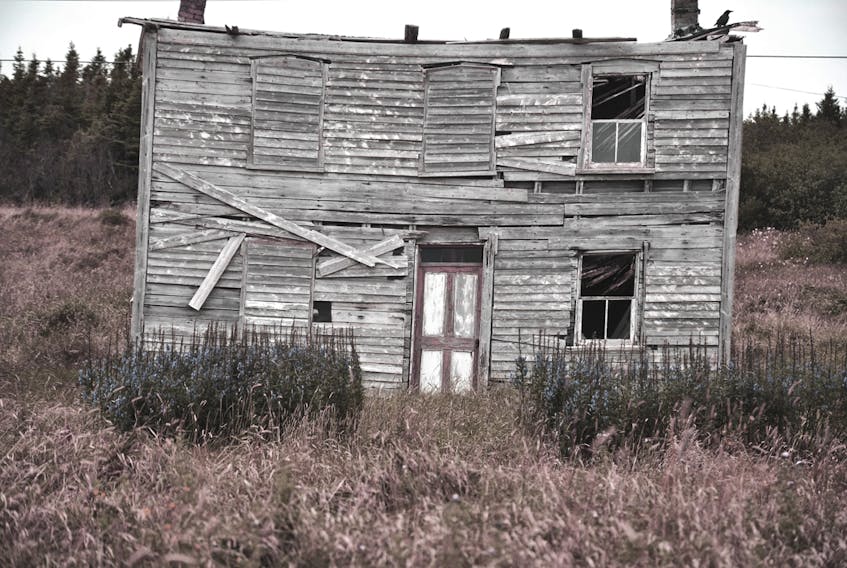“I never thought that I’d ever live,
To see such going on;
To think that the end could ever have been,
But now, she’s gone, boys, she’s gone.”
— “She’s Gone, Boys, She’s Gone,” Wayne Bartlett, 1992
The asphalt snakes through the undulating Doe Hills, cracked and crumbling. Rounded white boulders hunch like doughboys in the pea-soup fog.

A flashing light penetrates the mist. It’s the moose warning signal, the government’s final attempt to keep the massive beasts off what was then a busy highway.
It stopped working about six months after it was installed in 2020, two decades ago now.
At the time, it was touted as heads above the faulty detection system put in place in 2011, but even state-of-the-art technology was no match for the island climate and most saw it for what it was — a thumb in the dike; something to placate people worried about moose-vehicle collisions as the real worry loomed much larger: the province’s slide towards an inevitable and much bigger crash of the financial kind.
A hulking creature stands stock-still in the middle of the road, blinded by the glare, its neck flap quivering in silhouette. Breath gusts from its nostrils in twin streams. It waits a moment, then ambles off knee-deep through a copse of alders. The branches make a rustling sound.
It seems appropriate the system finally manages to sound the alarm when there’s no soul around to heed it.
It’s been 10 years since the place was abandoned. The island, I mean, not the Doe Hills.
The Doe Hills were bleak at the best of times. It’s in what used to be St. John’s where the wreckage is the worst.
After the province crumpled under the financial triple-whammy of cumulative debt, decades of overspending and Muskrat Falls, Labrador joined up with Quebec, and Newfoundland and Labrador was no more.
Successive governments had failed to sufficiently heed the infamous 2017 forecast that we’d be over the cliff and belly up in 10 years. There was some feeble belt-tightening, to be sure, but no politician could quite bring themselves to be the architects of Resettlement 2.0 or to shut down rural hospitals or implement massive layoffs in the civil service.
As usual, they worried more about re-election than anything else, giving no thought to the notion that there’s little glory in skippering a sinking ship.
The Doe Hills were bleak at the best of times. It’s in what used to be St. John’s where the wreckage is the worst.
The Colonial Building on Military Road, finally restored in 2021, is about the only edifice left unscarred. How’s that for irony, when Colonial Building was home to what had been Newfoundland’s most infamous riot in 1932 — windows smashed, stones hurled, the place looted for liquor, people beaten back by police with batons — when the government of Prime Minister Sir Richard Squires was accused of corruption with the country on the brink of economic collapse.
That seems nothing now when you consider Confederation Building in the last goings off. Shards of blue glass littering the hill, the statue of Danny Williams hauled down, flags set ablaze. It was something to see, the cadre of grey-haired seniors marching back down the parkway when it was all over, hoisting canes and walking sticks and caterwauling their victory.
They were tired of getting blamed for everything after having paid for everything, they said.
Of course, Cabot Tower’s still there on Signal Hill, but the downtown’s a ruin — windows beaten out, buildings pocked and looted. Higgledy-piggledy houses with their darkened windows like unseeing eyes. The harbour bereft of boats. The church bells silent, streets left to the skittering rats.
They say Ed Martin was the last man to go, so he turned off the lights, but that’s probably just a good story.
All that’s left of island culture now is on Fogo. The chartered planes and the private yachts can hardly keep up with tourist demand, they say. The well-heeled and the homesick come clamouring for a feed of Bering Sea-brined salt fish and Nova Scotia lobsters. Vamps knitted by nan and raisin buns, “Mussels in the Corner” and “The Kelligrews Soiree.” They pay upwards of $2,500 a night, so I’ve been told.
But that’s just what I’ve been told.
Pam Frampton is The Telegram’s associate managing editor. Email [email protected]. Twitter: pam_frampton.









